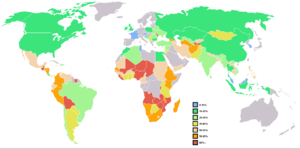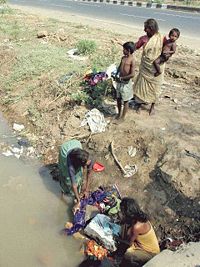Poverty threshold
2008/9 Schools Wikipedia Selection. Related subjects: Citizenship; Economics
The poverty threshold, or poverty line, is the minimum level of income deemed necessary to achieve an adequate standard of living in a given country. In practice, like the definition of poverty, the official or common understanding of the poverty line is significantly higher in developed countries than in developing countries.
Almost all societies have citizens living in poverty. The poverty threshold is useful as an economic tool with which to measure such people and consider socioeconomic reforms such as welfare and unemployment insurance to reduce poverty.
Determining the poverty line is usually done by finding the total cost of all the essential resources that an average human adult consumes in one year. This approach is needs-based in that an assessment is made of the minimum expenditure needed to maintain a tolerable life. This was the original basis of the poverty line in the United States, whose poverty threshold has since been raised due to inflation. In developing countries, the most expensive of these resources is typically the rent required to live in an apartment. Economists thus pay particular attention to the real estate market and housing prices because of their strong influence on the poverty threshold.
Individual factors are often used to account for various circumstances, such as whether one is a parent, elderly, a child, married, etc. The poverty threshold is adjusted each year. In 2007, in the United States of America, the poverty threshold for a single person under 65 was US$10,787; the threshold for a family group of four, including two children, was US$21,027.
Defining poverty thresholds
Poverty thresholds can be defined in different ways:
- Social Security benefit based. If a government guarantees to make income up to some particular level then it may be presumed that that level is the poverty threshold. This is a problematic definition, because an uncharitable government may reduce the guaranteed income, thus reducing the incidence of poverty so defined while increasing the incidence of actual poverty.
- A relative income line, related to some fraction of typical incomes. This excludes the wealthiest individuals from the calculation. For example, the OECD and the European Union uses 60% of national median equivalised household income.
- A relative figure fixed in time and only adjusted for inflation - thus avoiding the possibility that if income inequality increases, then poverty may otherwise also increase.
- When the World Bank calculates its "$1 a day" statistics, it uses a poverty threshold.
- A basket of goods deemed neccessary to live at the socially accepted minimum, such as the U.S. government uses.
Absolute poverty
A measure of absolute poverty quantifies the number of people below a poverty threshold, and this poverty threshold is independent of time and place. For the measure to be absolute, the line must be the same in different countries, cultures, and technological levels. Such an absolute measure should look only at the individual's power to consume and it should be independent of any changes in income distribution. Such a measure is only possible when all consumed goods and services are counted and when PPP-exchange rates are used (see purchasing power parity). The intuition behind an absolute measure is that mere survival takes essentially the same amount of resources across the world and that everybody should be subject to the same standards if meaningful comparisons of policies and progress are to be made. Notice that if everyone's real income in an economy increases, and the income distribution does not change, absolute poverty will decline.
Measuring poverty by an absolute threshold has the advantage of applying the same standard across different locations and time periods, making comparisons easier. On the other hand, it suffers from the disadvantage that any absolute poverty threshold is to some extent arbitrary; the amount of wealth required for survival is not the same in all places and time periods. For example, a person living in far northern Scandinavia requires a source of heat during colder months, while a person living on a tropical island does not.
This type of measure is often contrasted with measures of relative poverty (see below), which classify individuals or families as "poor" not by comparing them to a fixed cutoff point, but by comparing them to others in the population under study.
The term absolute poverty is also sometimes used as a synonym for extreme poverty.
According to a UN declaration that resulted from the World Summit on Social Development in Copenhagen in 1995, absolute poverty is "a condition characterised by severe deprivation of basic human needs, including food, safe drinking water, sanitation facilities, health, shelter, education and information. It depends not only on income but also on access to services."
David Gordon's paper, "Indicators of Poverty & Hunger", for the United Nations, further explains that absolute poverty is the absence of any two of the following eight basic needs:
- Food: Body Mass Index must be above 16.
- Safe drinking water: Water must not come from solely rivers and ponds, and must be available nearby (less than 15 minutes' walk each way).
- Sanitation facilities: Toilets or latrines must be accessible in or near the home.
- Health: Treatment must be received for serious illnesses and pregnancy.
- Shelter: Homes must have fewer than four people living in each room. Floors must not be made of dirt, mud, or clay.
- Education: Everyone must attend school or otherwise learn to read.
- Information: Everyone must have access to newspapers, radios, televisions, computers, or telephones at home.
- Access to services: This item is undefined by Gordon, but normally is used to indicate the complete panoply of education, health, legal, social, and financial ( credit) services.
For example, a person who lives in a home with a mud floor is considered severely deprived of shelter. A person who never attended school and cannot read is considered severely deprived of education. A person who has no newspaper, radio, television, or telephone is considered severely deprived of information. All people who meet any two of these conditions — for example, they live in homes with mud floors and cannot read — are considered to be living in absolute poverty.
Relative poverty
A measure of relative poverty defines "poverty" as being below some relative poverty threshold. For example, the statement that "households with an accumulated income less than 50% of the median income are living in poverty" uses a relative measure to define poverty. In this system, if everyone's real income in an economy increases, but the income distribution stays the same, then the rate of relative poverty will also stay the same.
Relative poverty measurements can produce odd results in small or unusual populations. For example, if the median household in a wealthy neighborhood earns US$1 million each year, then a family that earns US$100,000 would be considered poor on the relative poverty scale, even though such a family could meet all of its basic needs. At the other end of the scale, if the median household in a very poor neighbourhood earned only 50% of what it needs to buy food, then a person who earned the median income would not be considered poor on a relative poverty scale, even though the person is clearly poor on an absolute poverty scale.
Measures of relative poverty are almost the same as measuring income inequality: If a society gets a more equal income distribution, relative poverty will fall. Following this, some argue that the term relative poverty is itself misleading and that income inequality should be used instead. They point out that if society changed in a way that hurt high earners more than low ones, then relative poverty would decrease, but every citizen of the society would be worse off. Likewise in the reverse direction: it is possible to reduce absolute poverty while increasing relative poverty.
The term relative poverty can also be used in a different sense to mean "moderate poverty" –- for example, a standard of living or level of income that is high enough to satisfy basic needs (like water, food, clothing, shelter, and basic health care), but still significantly lower than that of the majority of the population under consideration.
Basic needs
Some measurements combine certain aspects of absolute and relative measures. For example, the Fraser Institute publishes a basic needs poverty measure for Canada. According to the Fraser Institute, "the basic-needs approach is partly absolute (the list [of necessities] is limited to items required for long-term physical well-being) and partly relative, reflecting the standards that apply in the individual's own society at the present time." The Fraser Institute's list of necessities for living creditably in Canada includes not only food, shelter, clothing, and health care, but also personal care, furniture, transportation, communication, laundry, and home insurance. It is criticized for not including any entertainment items like cable television, daily newspapers, and tickets to movies or sporting events.
Criticisms
Using a poverty threshold is problematic because having an income marginally above it is not substantially different from having an income marginally below it: the negative effects of poverty tend to be continuous rather than discrete, and the same low income affects different people in different ways. To overcome this problem, poverty indices are sometimes used instead; see income inequality metrics.
A poverty threshold relies on a quantitative, or purely numbers-based measure of income. If other human development-indicators like health and education are used, they must be quantified, which is not a simple (if even achievable) task.
Overstating poverty
Public and private charitable gifts are not counted when calculating a poverty threshold. For example, if a parent pays the rent on an apartment for an adult daughter, that money does not count as income to the daughter. If a church or non-profit organization gives food to an elderly person, that also does not count as income. Rea Hederman, a senior policy analyst in the Centre for Data Analysis at the Heritage Foundation, a conservative think tank in the United States, complained,
- The official poverty measure counts only monetary income. It considers antipoverty programs such as food stamps, housing assistance, the Earned Income Tax Credit, Medicaid and school lunches, among others, "in-kind benefits" -- and hence not income. So, despite everything these programs do to relieve poverty, they aren't counted as income when Washington measures the poverty rate.
Studies measuring the difference between income before and after taxes and government transfers, however, have found that without these programs poverty would be roughly 30% to 40% higher than the official poverty line indicates - despite many of their benefits not being counted as income.
Understating poverty
The U.S. poverty threshold in particular has been criticized for understating poverty, by using an outdated "basket of goods" to set the standard. While cost of these goods is adjusted for inflation every year, the basket of goods itself remains the same. It excludes the cost of items that were rare among poor Americans in the 1950s, but which are now common, such as a telephone, a car and a microwave oven. Mollie Orshansky, who devised the original goods basket and methodology to measure poverty, used by the U.S. government, in 1963-65, suggested an updated list in 2000. She found that the point where a person is excluded from the nation's prevailing consumption patterns, is roughly 170% of the official poverty threshold.
Furthermore, in developed countries, such as the U.S., poverty tends to be cyclical. Thus, the poverty line only indicates how many people are poor at any one point in time. It does not report the number of people who will experience poverty during their lifetimes. In the U.S. for example, roughly 12%-13% fall below the poverty line in any given year, but roughly 40% will experience poverty at some point over a ten-year timespan.

